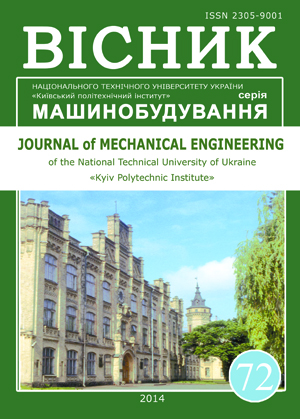BIOMECHANICS OF THE ANTERIOR ABDOMINAL WALL MAN WITH IMPLANTS WITH FUNCTIONAL LOAD
DOI:
https://doi.org/10.20535/2305-9001.2014.72.28496Keywords:
біомеханіка, черевна стінка людини, жорсткістні характеристики, ортотропні механічні властивості, біологічні тканини, апоневроз, черевний тиск, сітчастий імплантат, пошкодження, тонкостінна неоднорідна оболонка, несуча здатність, скінченно-елементна моделAbstract
The study of the structural organization of the biomechanical system of the abdominal wall with damaged human muscular-aponevrotyc biological tissues. The estimation of its load-bearing capacity in functional power load pressurized tissues in normal and in the case of damage repair of the abdominal wall by alloplasty. An adequate analytical simulation model of a thin-walled cylindrical fragment inhomogeneous shell with equivalent stiffness parameters of a homogeneous isotropic material layer and the finite element model of the prototype flat - an analogue of the characteristics of a transversely isotropic material. Practical application of the method of calculation carried out to determine the relationship of abdominal pressure and allowable stresses of the aponeurosis of the radius of the spherical segment of a cylindrical shell for three cases of the biomechanical state of the abdominal wall in the norm, with injuries, after alloplasty by mesh implants. Using finite-element model of the prototype flat - an analogue of the abdominal wall revealed that concentration by Mises equivalent stresses in the zone of damage aponeurosis compared with values in normal growing six times and strain twice. Bearing capacity multilayer membrane biological tissues of the abdominal wall is mainly determined person as biomechanical tissue aponeurosis.References
Egiev V.N. Sovremennoe sostojanie i perspektivy gerniologii. Gerniologija- Herniology, 2006, no. 2, pp. 5-10.
Feleshtins'kij Ja.P. Pіsljaoperacіjnі ventral'nі grizhі [Postoperative ventral hernias]. Kiev, 2012. 200 p.
Тsaplin S.N. Biomehanika perednej brjushnoj stenki, vybor optimal'nogo operacionnogo dostupa i tehniki zakrytija laparotomnoj rany: аvtoref. dis. na soisk. uchenoj stepeni kand. med. nauk. Spec. 14.01.17 “Hirurgija”. Moscow, 2011. 24 p.
Fedorov A. E., Adamov A.A. Rossijskij zhurnal biomehaniki- Russian Journal of Biomechanics, 2007, Vol. 11, no. 1. pp. 76–83.
Lazarev S.M., Begun P.I., Baga D.K., Lebedeva E.A. Materialy 5 mezhdunarodnoy konferencii “Aktual'nye voprosy gerniologii” (Materials of the 5th Intern. conf. “Actual questions herniology”). Moscow, 2006, pp. 54–55.
Pashkovin T. N., Sarvazjan A. P. Biomehanika- Biomechanics, 2003, no. 3, pp. 105–115.
Zhukovskij V.A. Polimernye jendoprotezy dlja gernioplastiki [Polymer implants for hernia repair]. Sankt Petersburg, Jeskulap, 2011. 114 p.
Kazakov V.A. Abdominal'nyj kompartment sindrom u pacientov s travmoj zhivota i ostroj hirurgicheskoj patologiej (Obzor literatury) / Kazakov V.A., Aparcin K.A. // Bjulleten' VSNC SO RAMN, 2006, №5 (51), s.308-314.
Pisarenko G.S. Jakovlev A.P., Matveev V.V. Spravochnik po soprotivleniju materialov, 2-e izd.,pererab. i dop. [Handbook on the strength of materials]. – Kiev: Naukova dumka, 1988. 736 p.
Bate N., Vilson E.Chislennye metody analiza i metod konechnyh jelementov [Numerical methods of analysis and finite element method]. Moscow, Strojizdat, 1982. 447p. 11. ANSYS Workbench User's Guide, Release 12.1

